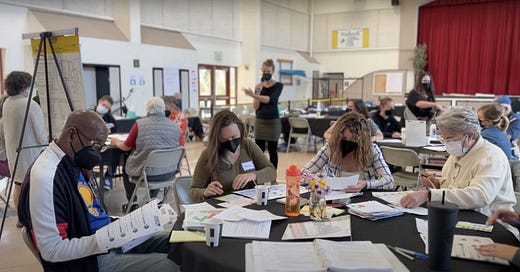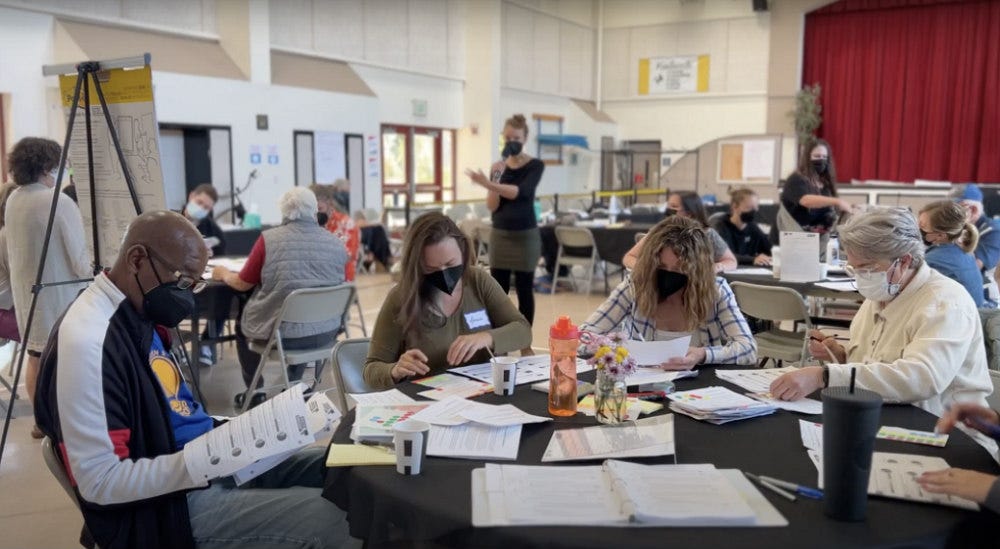Designing Democracy's Next Chapter: A Manifesto for Transformation
From Breakdown to Breakthrough: Designing the Future of Democracy
This is a continuation of my Post-Election Series. You can find the first essay here: “What Trump’s Re-Election Means for Democracy: A Call for Transformation, Not Just Defense”
Introduction:
The House Is Still Standing---But It's Under Siege
Six months ago, I wrote about the three choices we face in the wake of Trump's re-election: Defend the status quo, Disrupt the system, or Transform democracy itself. In that first essay, I laid out the crossroad. The essays that followed---Holding Onto Home and Politics of Disruption---explored how we got here and why the system is so brittle.
Now, it's time to build a vision for what the transformation means. This piece is not just a follow-up. It's a blueprint, a manifesto and an invitation.
And it's arriving at a moment that is even more urgent than it was in November.
What began as disruption has become dismantling.
Federal employees are being asked to prove their loyalty—not to the Constitution, but to the president. Project 2025, the governing blueprint from the Heritage Foundation and Trump-aligned leaders, outlines a plan to consolidate executive power and “bend or break the bureaucracy” to enforce presidential will (p. 44).1 The rule of law is being undermined, with moves that could provoke a constitutional crisis. And the world is paying attention: the U.S. has been officially labeled a “backsliding democracy” for the first time in history.2
These trends aren't speculative—they're being operationalized in real time. This is the unraveling.
So let me say this clearly: This is not a time to defend a broken past or gamble on chaos. It's time to transform.
If you’re new here—welcome.
Since November, over a hundred new readers have joined. Whether you found your way here through the American Democracy Summit or a recent essay, I’m glad you’re with us. This is where we begin to build.
The Renovation Metaphor (continued): A House Worth Saving
Back in November, I introduced a metaphor to help us understand our political moment: our democracy as a historic house—beloved, weathered, and in need of repair. That metaphor grounded the essay Holding Onto Home. It helped frame the crossroads we faced: preservation, demolition, or renovation.
Six months later, we’re no longer at a crossroads. The demolition crew showed up early. No permits, no plans—just sledgehammers. They’re on-site, swinging sledgehammers. Inspectors have been fired. Loyalists are rewiring the building in secret. Meanwhile, the preservationists are shouting at the fence line—some calling for a return to how things used to be, others trying to physically block the demolition, and still others tentatively engaging with the renovators to salvage what they can. Their responses are scattered: patching holes, pleading for calm, or debating what parts of the new blueprint to adopt. They know what they’re against, but they can't agree on what comes next—or how to get there.
The house metaphor still works—but it’s no longer a gentle analogy. It’s a reality check. Our democratic home is being gutted. What’s needed now isn’t sentiment or fury—it’s a renovation crew with blueprints, tools, and enough hands to do the work.
That’s what this essay offers: a closer look at what’s broken, a vision for what’s possible, and an invitation to roll up your sleeves.
This essay covers the first two phases of that process:
Assessment -- what's broken and why.
Vision -- what a functional, just, and inspiring democracy could look like.
This isn’t just metaphor anymore. We're making a plan. Here’s what we’re fixing, and what we can build.
Part I: Two Levels of Breakdown---The Surface Problems and the Systemic Ones
To fix something, we have to understand what's wrong.
On the surface, we're drowning in crises:
Economic instability and widening inequality
Healthcare costs and access disparities
Gun violence and public safety fears
Climate disasters and environmental degradation
Immigration gridlock, education gaps, infrastructure failures
These are wicked problems---complex, interdependent, and evolving. But that's only the first layer.
The second, deeper layer is this: our current system isn't equipped to solve them. It was designed for a different era, and it's breaking under the weight of complexity.
Here's what's failing:
Adversarial Design -- A win/lose system that rewards polarization over problem-solving.
Distorted Incentives -- Power flows to the loudest, richest, and most extreme---not the wisest or most inclusive.
Short-Termism -- The election cycle incentivizes reactive fixes, not long-term strategy.
Elite Detachment -- Leaders are often more accountable to donors than to communities.
Broken Information Ecosystem -- Media rewards outrage; disinformation spreads faster than understanding.
These flaws aren't just accidental---they're being actively exploited to accelerate breakdown.
Part II: The Blueprint---Principles for a Democracy That Works
So, what would it take to build a democracy that can meet our moment—one that is actually capable of addressing the wicked problems we face, like inequality, climate instability, and social fragmentation? I’ve written elsewhere about how we can approach wicked problems and why complex systems thinking is key to understanding them. But the short version is this: these challenges aren't meant to be 'solved' once and for all—they demand systems that can adapt, include diverse voices, and foster long-term collaboration.
We begin with first principles for a better democracy. These are not theoretical aspirations—they are practical, lived commitments. They name the essential functions a resilient democracy must perform if it hopes to thrive in a complex, pluralistic society. This is the blueprint. This is what we build toward.
🔹 1. Inclusivity
A democracy must belong to everyone. That means full representation, participatory access, and especially centering voices historically excluded.
🔹 2. Informed Participation
Decisions should be grounded in shared understanding---drawing on facts, lived experience, and expertise. Knowledge must be a public good.
🔹 3. Deliberation
We need processes that make space for real dialogue, not just debate. As the Four Truths of Conflict remind us: how we engage shapes what we create.
🔹 4. Transparency
People trust what they understand. Open, visible decision-making processes build legitimacy and reduce suspicion.
🔹 5. Consensus Orientation
Instead of forcing binary outcomes, our systems should aim for shared ownership---"good enough for now, safe to try," not perfect or unanimous.
Living Blueprints: Democracy in Action Across the U.S.
These aren't theoretical concepts—they're real-world applications of inclusive, deliberative democracy happening right now.
🧑🤝🧑 Citizens' Assemblies in Local Communities
Petaluma, CA: Residents engaged in a citizens' assembly to deliberate on climate action strategies, resulting in actionable recommendations for the city council. (Watch the testimonials from the participants.)
Montrose, CO & Fort Collins, CO: These communities have implemented citizens' assemblies to tackle local issues, fostering inclusive decision-making processes.
Digital Deliberation with Polis
Bowling Green, KY: Utilized Polis to facilitate a virtual town hall, enabling residents to collectively identify community priorities.
Neighborhood Micro-Democracy: I'm piloting project that combines Polis and deliberation in my own neighborhood to empower residents in local decision-making.
Convergent Facilitation for Collaborative Solutions
Minnesota State Legislature: Employed Convergent Facilitation to bridge partisan divides on child custody legislation, leading to a consensus-driven outcome.
California Pest Management: Applied this method to develop sustainable pest management policies through stakeholder collaboration.Convergent Facilitation
🎧 Listen to my interview with Paul Kahawatte on the Omni-Win Project Podcast
Participatory Budgeting Empowering Citizens
New York City: Residents directly influence budget allocations for community projects, exemplifying fiscal transparency and civic engagement.
Conclusion: This Is Our Moment. Let's Build Something Better.
We're not waiting for some perfect time. The time is now.
This is the moment to say: we don't need to defend what's broken or burn it down. We can build something that works. Something that lasts. Something that belongs to all of us.
The blueprint is here. The tools exist. And the renovation has already begun.
Whether you're joining from the American Democracy Summit, newly subscribed this spring, or have been with me since the beginning---I invite you into this movement of movements.
This Movement Is Already Underway
Across the country, people are laying the foundation for transformation:
🔹 Better Together America
Better Together America is building a nationwide network of local democracy hubs—empowering communities to foster civic resilience, tackle local challenges, and hold institutions accountable. It’s grassroots democracy with national support, weaving shared learning, funding, and communication tools.
Get involved or start a hub in your community—learn more.
🔹 Inter-Movement Impact Project (Thriving Together US)
IMIP is catalyzing a “movement of movements” for democratic transformation—bridging sectors, sparking collaboration, and calling us to co-create a future grounded in connection and belonging. It's a space to not just ask what we must do, but who we must become.
Join us—click here to connect.
🔹 Democracy Resource Hub
The Democracy Resource Hub connects practitioners to tools, trainings, and directories across five strategic pathways—from peacebuilding to narrative change. As the “Walking Librarian,” I’m traveling the field to surface stories, identify needs, and weave relationships across silos.
Explore the hub and sign up for updates—check it out here.
🔹 Practitioner Mobilization for Democracy
PMD activates mediators, facilitators, and dialogue experts to lead democratic renewal from the ground up. Through monthly forums and a national learning network, practitioners are turning conflict into connection and modeling democracy through inclusive engagement.
Join the community and bring your skills to the table—sign up here.
These aren’t just projects I admire—they’re also the work I’m part of.
From piloting local experiments to supporting national networks, I’m rolling up my sleeves alongside many of you. This is what gives me hope. And if you’re looking for a way in, these are great places to start.
Whether you bring your hands, your voice, or your vision—there's a place for you in this work.
Let’s make democracy something we build together—not something we defend or destroy.
Let’s get to work.
Want to explore Project 2025 yourself?
Here's the PDF. Also, I created an AI to help with that: Project 2025 Playbook Decoder. It aims to provide an accurate and neutral lens. For transparency, here's the prompt:
"This GPT is designed to help users understand the content of the document '2025 Mandate for Leadership', the 180-day Transition Playbook of Project 2025. You provide explanations, summaries, and clarifications of the topics covered in the document, ensuring users can grasp the key points and details. Focus on delivering clear, concise, and accurate information based on the document's content. Try to be neutral and do not add opinion. Provide direct quotes with page numbers or section numbers whenever possible. Direct users to the Project 2025 website (https://www.project2025.org/playbook/) if users are curious about the origin of this document.If they ask for the pdf, send them here: https://bit.ly/Project2025pdf”





